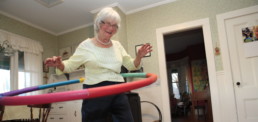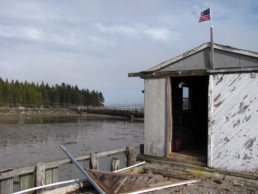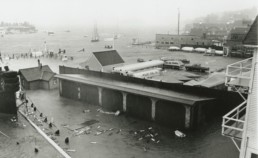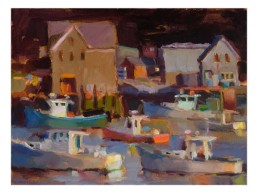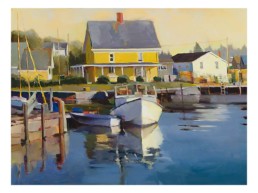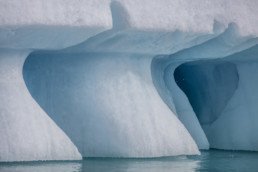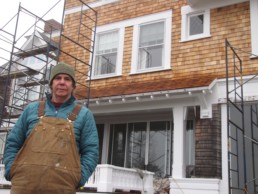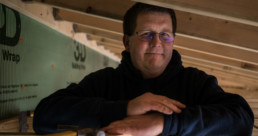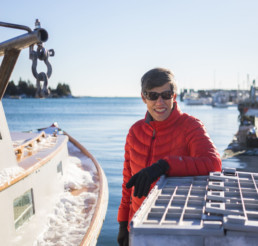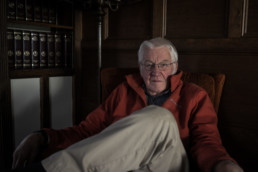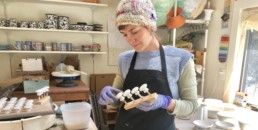Smiles, Hugs, and Hospitality
Smiles, Hugs, and Hospitality
Island matriarch marks 66 years on island.
STORY AND PHOTOS By SCOTT SELL
A confession: I never learned to hula hoop. Not enough to keep it from hitting the floor, anyway.
It’s a late November afternoon and quiet on Islesford—also known as Little Cranberry, one of the five that make up the town of Cranberry Isles—and I’m about to get my first official hula hooping lesson from Anna Fernald.
There are two things you need to hula hoop successfully, Anna says. A good beat and lots of space. After putting on her slippers, she pulls chairs to the edge of the living room and puts on a Mark Knopfler and Emmylou Harris album of duets. She cranks the volume so you can hear it in any room in the house.
“OK,” she says, picking up one of her three colorfully striped hoops. “You’re counting on your body to hold it up, but you want to have the hoop cling to you and do the work.”
And with a good twist of her wrist, the hoop is up and going, smooth and steady. She takes small steps around the room with her arms out to her side, letting the drums and Knopfler’s guitar on “Beachcombing” keep her in time. At one point, the hoop begins to wobble a little and Anna laughs as she corrects it, becoming newly focused. The song ends and she grabs the hoop, pulls it over her head and with a great big smile, she holds it out to me.
“Your turn!”
She will be 86 this year.
It’s rare to see Anna not smiling. Even when she’s worried or thinking about something seriously, her eyes sparkle and dance. She’s someone who’s apt to give you a big hug when first meeting you, taking your hands and saying, “Oh, I’m just so glad you’re here!”
The matriarch of one of Islesford’s larger families and a welcoming ambassador to her island home, she was born in Ellsworth and grew up in Salisbury Cove, eight miles from Bar Harbor. Her father, a laborer, often worked as a plumber and mason and even helped to build the Cadillac Mountain Road. Her mother took care of her and her four siblings, including a sister who was mentally handicapped.
“Now here I am, 66 years later,” she says.
What was it like to come out to the island?
“Awful. The day I moved out from my parents’ house, I stayed up in my bedroom and cried. Warren came in and asked, ‘What’s the matter, dear?’ and I said, ‘You know what the matter is.’ I did not want to come out here.”
Of course, she had to: Warren’s family had been on Islesford for generations and it was expected that he would continue fishing and start his family on the island. His grandfather bought their house from a Coast Guard captain four years earlier for $1,000 and when giving it to Warren and his new bride, he said his one condition was that he wanted them to fill it up.
“Well, we did,” Anna says. “And then some.”
Almost every night, and especially during the summer, the house would be crammed with people. In addition to their six children—Bruce, Mark, Dan, Karen, Kelly, and Paul—there would be friends, neighbors, and sternmen living in the attic, relatives visiting for the summer.
“You never knew who you were going to see for dinner,” she says. “I was going through about a bag of potatoes every night.”
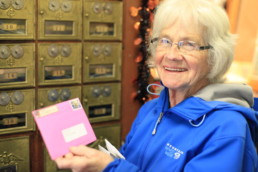
It was the same when I was out on the island last summer to film the island’s second annual community “rowathon,” a 10-kilometer fundraising row around the island. Over the course of the morning on the day of the event, nearly everyone who was involved in the race passed through her living room to squeeze onto the sofa and loveseats and drink a cup of coffee while Anna moved quickly between the living room and the kitchen to get people a warm-up or serve yogurt with her famous cranberry jam or bring out a photo album to share. Later that day, she was perched at the bow of a Super Mario Brothers-themed rowboat dressed as Princess Peach, complete with parasol.
“Oh, it’s a blast!” she laughs. “There’s always something going on, someone coming in, needing something to eat, telling a story. Some people ask, ‘How do you do that?’ and I say, ‘How do you not do it?’”
She has made a point of keeping at least one of her spare bedrooms consistently filled: several Island Institute Fellows have boarded with her in the past and the administrative assistant for the town’s select board has been living in the attic for six years now. She thinks having had a lively house full of people of all ages is the reason her children are as outgoing and personable and caring as they are. It might also be how she stays so youthful.
“I think for me and my age, I’m the only one who’s out and about and keeping active. And I don’t know why that is unless I’ve forced myself to do it, because I want to keep myself that way. Some people as they get older, they get focused on their projects, whether that’s quilting or woodworking or whatever. Mine is staying active and hanging out with people, I guess.”
Anna takes two walks around the island a day. One after coffee and Bible study in the morning and one in the late afternoon before she starts cooking dinner. She points out where everyone lives, who lived there before, the remodeling one family is doing, the hard times another is having. The island is starting to slow down, she says, not just seasonally, but as a community: a cyclical ebb that most islands experience.
A wave of people has moved off-island for one reason or another. There are fewer regular town events. And for the next two years, Islesford students will be going across the water to the newly reopened Longfellow School on Great Cranberry Island each day, leaving Islesford’s Ashley Bryan School empty. She misses the kids. She often stops at the school—a quick walk across the road from her house—and sits on the swing set, wishing she could see them at lunchtime.
On the way out to the island’s southern beach, she stops at the small cemetery where Warren, several generations of his family, and many of her contemporaries are buried. It’s been increasingly difficult for Anna to lose members of their small community; a few years ago, two of her close friends passed away within two days of each other. Warren had died the year before. Pointing out who was who, she finally comes to Warren’s headstone which is, by far, the most beautiful.
One night, years ago, when they were looking up at the sky during an after-dinner walk, Warren said, “When I die, I hope God lets me fish the Big Dipper.” That stuck with Anna so when he died in 2005, she asked Rick Alley, an island fisherman and artist, to draw Warren’s lobster boat—F/V Mother Ann—among the stars, and then had the image engraved on his headstone.
“He was a real people person, too,” she says. “He had his summer shop down on the dock and tourists would come off the boat and talk to him while he fixed traps. Some people get annoyed with that sort of thing, but he loved it.”
Before she heads home, she stops in at the post office. She had been in earlier, too, hoping the mail had been sorted. Now, among a pile of bills and magazines she pulls out of her postal box is a small purple envelope. It’s what she’s been waiting for.
“A card from David,” she says, holding it to her chest and grinning ear to ear. “I get one every day.”
In the early 1990s, Anna attended a Christian retreat in Bar Harbor and has done so every year since. Because Warren wasn’t interested, she went alone. Each summer, she’d make more friends, including David, with whom she has kept in touch over the last 25 years. Recently, they connected and have developed a relationship that has gotten more serious in the last few months.
“If you told me that at 85, I’d be dating an accountant from Ellsworth who’s 15 years younger, I’d say you’re crazy,” she says, blushing a little. “But you never know what’s around the next bend!”
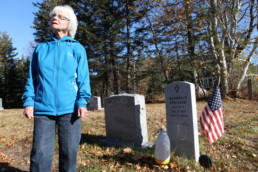
They have been writing and emailing one another every day while he’s in Florida for the fall. In January, he’ll return to Maine and come visit her on Islesford. Anna also foresees spending more time on the mainland with David.
“There’s less keeping me here day to day, and I’m more willing now to leave for a while and come back when I want to,” she says. “Not that I ever want to leave the island forever. I don’t. This is home.”
Back at Anna’s house, a beef stew is being mopped up with biscuits around the dining room table. Two of her four sons, Bruce and Paul, and two neighbors are over for supper tonight. Over warm gingerbread, everyone shares their own story about driving in bad weather as news of a pre-winter snowstorm emerges.
The phone rings in the next room and Anna excuses herself.
Twenty minutes later, she comes back in with a smile that refuses to leave her face.
“That was David, calling from Florida,” she says, sighing. “He says hello to everybody.”
She reaches over to Bruce and lays her hand on his.
“I can’t wait for you to meet him.”
Scott Sell has worked as a reporter, a writing and multimedia teacher, and most recently, as the Island Institute’s in-house videographer. He is now a freelance writer and filmmaker, focusing primarily on documentary storytelling. His work has appeared in The New York Times, the New York Daily News, and The Washington Post.
Coldwater Coast
Coldwater Coast
By Jon Keller
The seagull hangs lifeless and gaunt from a rope. The wind is hard out of the east, leaping over the riprap causeway and flipping the water into neat lines of black and silver. The dead seagull twists in the wind, spins, its eyes now as clouded and gray and lost as the Atlantic skyline.
I stand on an 8-foot by 8-foot feed scow with the lobsterman named Oscar at the tiller. I hold a shovel in my fists. Over a 1,000 pounds of dead fish lie at my feet.
We are being watched by a series of surveillance cameras, and we are surrounded by an electric fence. There is an eagle in a spruce snag and Oscar points a single crooked finger at it as if he knows this bird from all others, and he grumbles, “Asshole.”
The eagle turns its head into the wind, leans forward and spreads its wings and swoops over us, arcs over the harbor and out of sight. Ten feet above us, a series of 100-yard-long nylon cables stretch from one edge of the lobster pound to the other. The cables hang slightly convex, like a drooping ceiling, and the feeling is that of being within an inverted dome with a floor made of seawater. When the wind blows, the cables vibrate and like some massive cello, the lobster pound moans and howls.
This is Oscar’s pound. He owns it with a partner. It’s essentially a low-tech lobster storage facility built out of a natural cove. The head of the cove is reinforced by a riprap causeway that connects the mainland to a small island, thereby protecting it from the battering of open ocean. The cove itself is not much larger than a football field, and it’s shaped like a horseshoe with a concrete dam spanning the open end of the shoe. The lower six feet of the dam is solid concrete with an inch-thick iron clapper in the center so the pound can be drained and cleaned in the spring. The top of the dam holds a wood-slat fence cut from a larch tree that locals call hackmatack and spaced to allow tidewater, but little else, to come and go.
Twice a day the pound is flooded naturally with sea water. When the pound is in use, as it is now, it is capable of holding over 60,000 pounds of lobsters, but how many Oscar and his partner put in there is not going to be written down by me. There are plenty in there. They feed on thousands of pounds of dead fish each week through the fall, and if someone were to fall into the pound, it would be difficult to set a foot on bottom without it landing on a lobster.
Oscar trusts me. We have become close friends despite the fact that he is old enough to be my father. His partner, after six years of knowing me, trusts me to a very limited extent—he trusts Oscar and he knows that Oscar trusts me. That is the way. I am new here, and if I were to have children here, they would be new here, as would their children. That is the way. No one truly moves here, no one steps fully into this world. In western Maine and in Midcoast Maine, in Portland or Camden or Bar Harbor, perhaps; but not in down east Maine. Down east Maine has yet to open itself, and the longer I stay here, the more obvious it becomes that when the door does finally open—as it inevitably will—the place itself will disappear in strict accordance with the swinging of that door.
~
I flip the shovel head upside down and push the fish racks into the water. The racks are the heads and spines and tails that remain after the fillets have been cut at a Canadian fish processor. The racks have been salted, dried and trucked here, and the fish smell nearly sweet. I flip them overboard, spread the meaty skeletons as evenly as possible while Oscar pilots around the small body of water. When he turns the scow side-to the wind, we catch an earful of cable harmonics, a soft hum that rises and falls as the wind gusts and calms.
Oscar shouts. A loud sigh: “Ahh.”
I’m at the bow of the feed scow. It’s more of a raft than a true scow: It has no sides, no gunwales, and only an inch of freeboard, depending on where I stand. Water slops up to my ankles as I turn and look at Oscar. He holds the tiller pinched between his legs and his arms are stretched high. He’s wearing bright orange insulated rubber gloves and he’s working his arthritic fingers as if guitar-plucking the overhead cables.
Far above, a half dozen gulls tilt and soar on shafts of wind.
Oscar has a white beard and the arms of his gray sweatshirt are cut off at the elbows, revealing hard, red, salt-sore skin. His hood is up. He wears black wristlets. In that instant, he reminds me of Charon. “Jesus Christ, Jon,” he says. “It’s beautiful. Isn’t it? Goddamned beautiful. Listen.”
His voice is urgent, nearly pleading, and his face is half-shadowed beneath the hood, and I see a slight glistening in the one exposed eye.
A moment passes.
He grunts and grabs the tiller and turns the scow, swallows, and we resume feeding the lobsters below. And there are plenty of lobsters below. There are tens of thousands of lobsters below.
~
Oscar was born here, raised here, and he fished here most of his life, but he calls himself a half-breed: his mother was from away. His father was a wharf owner and World War II hero whose lineage dates to the first wave of settlement in the harbor where Oscar lives. He met Oscar’s mother in Boston just after the war, and she too was different. She drove hours to take Oscar and his siblings to the library in Bangor to be sure they learned literature. She taught them music and art, and though Oscar’s early schooling was in a one-room schoolhouse with a woodstove in the corner, he went to Hebron on a scholarship, then to Wesleyan on another one.
But academia didn’t take and he bailed.
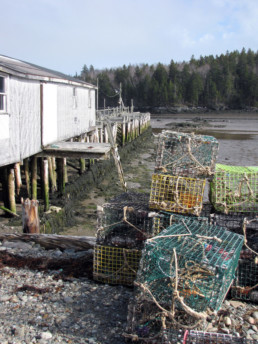
By then he’d gotten a taste of a world without lobsters and bait and fog. There were girls and jazz and drugs out there. He took off in a Packard. That was the sixties. He went south to Florida, then on to New Orleans, to New Mexico, to California. Big Sur and San Francisco and on up the coast and years disappeared but eventually he came home. He began lobster fishing again and he never stopped. He paid cash for a fiberglass boat with a diesel engine and in the days of wooden boats, he was the hotshot in that little harbor. The highliner. He had a ponytail down to his ass and he fished the untouched waters far outside the islands and peninsulas, and he paid attention. He bought a depth finder and watched the sea floor—called the bottom—and he learned the bottom—learned the holes, the underwater canyons and mountains and rock piles, the mud pockets and sand flats—and he built traps out of wood and he caught more lobsters than anyone in the harbor.
He lived in a small summer cottage beside the wharf with no running water and no power, but years trickled away and slowly he got the itch for something new, something different. He wanted to go. He’d come home and he’d proven himself to a crew of fishermen who’d been his peers right up until the day he left for private high school, but once again he wanted something else, something more.
He was different. He was a half-breed, a lobsterman with a head full of Shakespeare and Miles Davis and Tom Waits and John Donne, but he was also one of the very first guys on that piece of coast to catch 1,000 pounds of lobsters in a single day, which is nothing now, but in the days of wooden traps and small boats was huge. He didn’t go west when the itch to go came this time. Instead he rigged his boat with a tower and pulpit for tuna fishing and he set off offshore with coolers of beer and a grill and a fiberglass tank full of saltwater heated off the engine coils that he and his girlfriend used as an offshore hot tub as they sipped beer and watched gannets and gulls dive on the baitfish that bubbled from the sea while tuna and swordfish swarmed below. He chased and harpooned bluefin tuna from the Canadian border down to Cape Cod and back through the summers, cooked shark steaks and bluefish on the grill and drank beer in the evenings, then returned home each August in order to set his lobster traps in time for fall fishing.
~
It’s a basic concept: fill the pound in early fall when lobsters are cheap, feed them through the winter, and sell when the price peaks. But it’s a gambler’s trade. Most pounds in Maine no longer operate, in large part because a pound is a large investment in a market that’s affected by factors ranging from Canadian fisheries to Icelandic banks to the water temperature on the coast of Maine, and it’s an investment that’s subjected to incredibly harsh natural forces in an environment that they cannot even see.
It takes a certain kind to endure this. It’s not a farm and Oscar and his partner are not buying range cattle and shipping them to a feedlot then sending them to a slaughterhouse. If a cow gets sick, someone shoves a needle into it before the entire herd is infected, but lobsters are underwater and pound keepers have little to no control over what happens on the water’s surface, let alone on bottom. They can hang dead gulls like scarecrows to ward off other lobster-killing black-back gulls. They can string cables across to keep out crows and eagles. They can wrap the place with electric fencing and security cameras to fend off coons and otters and thieves with scuba gear and underwater flashlights, but in the end there is little to be done. A pound isn’t an indoor tank with monitors and aerators and thermostats and filters, nor is it a high-tech multinational fish farm—it’s a few guys in hooded sweatshirts tossing lobsters they caught into a fenced-off cove.
~
Now Oscar flips his hood off. He’s wearing a black baseball cap which reads Mercury. The feed scow is empty and I’m sweating and he turns us back toward the pound building. He releases the tiller and walks with me to the bow of the scow and with the weight, the bow dips below the surface and scoops a sheet of water that rinses the deck free of the remnant salt and bones and fish flesh. He returns to the tiller, and the bow rises, and we cross the pound.
The water is gray and a gentle twilight surrounds us. The eagle is back in the spruce snag, watching, but Oscar ignores it. We sit in his truck in front of the pound building. We smoke cigarettes. I drink beer; he drinks vodka. We watch the water. This is our routine. It’s been several years since I was his sternman, but he still recruits me to help feed the lobsters. Money no longer changes hands between us, and it remains unspoken that whatever one of us can do to help the other will be done. I help him feed lobsters and split firewood and fill in on his boat when he needs it. He lends me tools, gives me lobsters when I have company, and feeds me dinners when I’m alone.
The pound surface is calm despite the fact that not far below, tens of thousands of lobsters are hungrily tackling 1,200 pounds of cod racks. Darkness is falling, and on the far side of the harbor the rocky cape is dropping evening red. Oscar holds his cigarette crunched between his rubber-gloved fingers as he peers out to sea, and the wind sucks a steady line of smoke out the gap in the window.
We don’t say much because there’s nothing to say. I am leaving the harbor for a while—most of my things are stuffed into Oscar’s garage. I’ve been living here for eight years, longer than any place I’ve lived since childhood, and I’ve been here largely because Oscar gave me a job and thus access to a community from which I otherwise would have been shunned.
When his cigarette is nearly gone, he turns the radio down—it’s Jakob Dylan, the same CD that has been stuck in the player for two years now. “You know what, Mister Man,” he says, then pauses and in the quick silence I hear the hum of the pound cables like something on the back of my neck. Then he sighs and his shoulders and chest drop. He sucks beads of vodka from his mustache. “This ain’t bad,” he whispers. “This right here. Feeding the bugs, watching the sunset. Where would you rather be?”
I nod to him and say nothing. There’s no answer. We both know why I have to leave—it’s the same reason he left, the same reason he rigged his boat with tuna gear and took off each summer when he was my age—and I’m grateful that he hasn’t made me try to explain it. So I wait and secretly hope that he’s come up with some solution that will enable me to stay here forever.
“Did I tell you I caught a codfish yesterday? The thing is beautiful. He was absolutely gorgeous, coming up in my trap. Christ, his belly looked like the sky. Deep. Opaque. Fucking endless.” He makes a motion like simulating an explosion with his hands and the explosion stems from his temples as if he cannot fathom the codfish. I’ve seen him make the same motion when listening to Lang Lang or Miles Davis or reading certain poems out loud at his dinner table, or even watching something closely—a spider, a dragonfly, a gannet, a sunset.
Then he grunts, clears his throat, grins a child’s grin. “So I cracked him on the skull and put him in a bucket of seawater.”
He reaches slow into the back seat and grabs a plastic grocery bag. He sets it between us and carefully unfolds the bag and fishes out a beer. He opens it with an opener from his dashboard and hands it to me. He’s got one more beer in there and it’s wrapped together with a blue plastic ice pack. He refolds the bag and sets his gloves on top of it.
“I woke up thinking about that codfish last night. I couldn’t sleep after a dream like that. He was in my dreams, Mister Man. Goddamn codfish dreams. I’m getting old—I used to dream about tuna. That’s a power animal. You see them rip through the water out there and you never forget it. Cod are goddamned groundfish bottom feeders. That’s where my dreams have gone. So, I got up and sliced him and salted him and went out to the shop and got my drying racks out, then I called my old friend Don because it was already four in the morning, and he should be awake. You know what he said? He told me that monarch butterflies take several generations to get where they’re going, then he hung up.”
Oscar leans his head back and laughs, a quick bark of a laugh that turns into a full chest rumble. I sip my beer.
“Four in the morning and my hands smell like codfish and I got codfish in my dreams instead of tuna and he tells me that. Several generations. My father used to tell me to take care of my feet and never miss a chance to take a piss.”
With that he starts the truck and slowly backs up without turning his head. His gaze stays transfixed on the pound, as if he’s seeing something that I am not, and I suppose that after looking at this same spot for nearly 65 years, he is.
He turns the truck around and eases down the dirt road, onto the pavement and up the hill, then down the long driveway to my house. He lets the truck idle as we both get out, then he nods and says, “I couldn’t of done it without you.”
He puffs his chest and sighs. It’s dark up there in the trees, but we can see a lightness which is the ocean through the branches, and we hear the faint moan of the cables that protect the pound. I know he wants me to stay, to marry, to have children who will grow up in the harbor because there are so few left and no prospects to replace those few when they grow up and leave, but he doesn’t mention wives or children to me now, only looks down at his rubber boots, shakes his head and exhales slowly and loudly, then grins beneath his white beard, makes a slight gesture with his hands to indicate that probably we should hug, then says, “Well alright, Mister Man. Carry on.”
Jon Keller is is the author of the novel Of Sea and Cloud. He is a sternman in Washington County.
Is Maine Still Hurricane-Proof?
Is Maine Still Hurricane-Proof?
By NANCY GRIFFIN
The role weather plays in Maine life is as important as the sun rising–and far more likely to be talked about. On the coast, and especially on islands where life revolves around boats and ferries, knowing the weather in advance and preparing for it is vital. Often, it’s a matter of survival.
But preparations can prove inadequate. High winds, pounding rain and excessively high tides can knock out power lines, smash boats, wash buildings out to sea or fill them with water. When storms include snow and ice, the damage can last longer if power lines go down all over the state.
In the Atlantic region, hurricanes are one of the most destructive weather forces. New Orleans is still recovering from the utter devastation of 2005’s Katrina, one of the country’s deadliest hurricanes ever, while being battered by other, more recent destructive storms, and the New York-New Jersey area is still rebuilding after Superstorm Sandy.
Giving Storms The Cold Shoulder
Maine is luckier than most Atlantic states when it comes to hurricanes, as they generally run out of power by the time they reach us. The reason hurricanes rarely hit the coast, explained John Jensenius, warning coordination meteorologist with the National Weather Service in Gray, is the low temperature of Maine’s ocean water.
“The storm’s energy comes from warm waters, and 85 degrees Fahrenheit is not a Maine water temperature,” Jensenius said. “Once it hits cooler water, it doesn’t have the energy to maintain hurricane strength.”
Nor’easters and blizzards are Maine’s primary destructive storms. The state is more likely to get the winds, some flooding and rain as the aftermath rather than the brunt of the hurricanes themselves. Which does not mean Maine never gets hurricanes.
“In an average year we have zero hurricanes,” said Jensenius, but one might hit on average every 30 years. Most recently, Hurricane Bob was a close call in 1991, but was downgraded to a tropical storm. Still, Bob managed to kill three people in Maine. Gloria hit southern Maine in 1985, Donna in 1960, Edna and Carol in 1954.
Hurricanes may be rare, but the memories of them stick. Ted Turner, 67, of Swan’s Island, remembers the stories about the deadly hurricane of 1938, alternately known as the Great New England Hurricane and the Long Island Express. This hurricane, which killed 682 from Maine to Long Island, was only the third to hit New England since a deadly hurricane in 1635. Property damage in 1938 was estimated at $306 million, or $4.7 billion in today’s dollars.
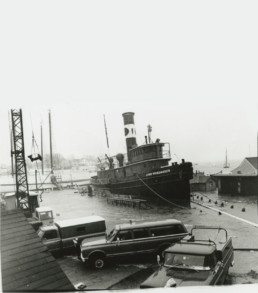
“I heard stories that it knocked down a lot of our old hotel,” said Turner, who is known on the island as an amateur historian.
Local memories are stronger of the back-to-back hurricanes of 1954–Carol and Edna, coming 11 days apart. The damage totaled in millions of dollars, and destroyed much of that year’s apple harvest.
Carol’s wind and rain began, Turner reported, “But then the sun came out and it was flat calm.” Unfortunately, this was by no means the end of it. “That was when the eye of the storm went over us. That’s when it’s calm,” he remembered.
In that calm, Turner recounted, a fellow from the island went down to the fishing wharf to check his boat. That’s when the storm came back with a vengeance out of the northwest. “He had to hide,” Turner said. “At the wharf, the wind picked up a building and destroyed it.”
George Young was just 25 at the time, lobstering from his own boat out of a family camp on Little Garden Island, one of the White Islands off Vinalhaven. “I’d like to forget that mess,” he said of Hurricane Carol.
“Salt water and seaweed were coming in all over the camp. It blew part of the afternoon and then all night long. We thought we would lose the camp. We got quite scared. It was terrible wind. I was ready to go out the back and go into the woods,” said Young. “We were lucky to keep the boats. Mine stayed on its mooring, but I lost my skiff.”
When morning broke, dead lobsters littered the shore. A Vinalhaven resident found Young’s skiff ashore in a harbor there and returned it. He got in his skiff, got to his boat and went home to Rockland. “I was glad to get home,” he said.
The name Carol was retired for all time for hurricanes after this storm.
Snow Hurricanes
Under certain conditions, when tropical air from a hurricane’s remnants pass over colder air, a “snow” or “white” hurricane can occur. One such occurrence, the Blizzard of 1888–also called the Great White Hurricane–caused destruction from Maine to the Chesapeake Bay area.
Maine more frequently experiences nor’easter storms that usually batter the coast between October and April, when cold winds blow in from the northeast, hit the warm, moist waters of the Gulf Stream, and produce copious amounts of rain or snow. Their high winds sometimes reach hurricane force, which can create super high tides and coastal flooding.
Hurricanes and the tropical storms that may turn into hurricanes are named. Some winter storms were named in the recent past, but the government now frowns on naming them “because a winter storm’s impact can vary from one location to another, and storms can weaken and redevelop, making it difficult to define where one ends and another begins,” said a National Weather Service spokesperson.
When private weather services took to naming winter storms, mostly for TV purposes, the language quickly escalated, giving us “Snowmageddon” and “Snowzilla.” Perhaps the National Oceanic and Atmospheric Administration (NOAA) and the National Weather Service figured there was nowhere to go from there. Especially since the so-called Storm of the Century had occurred in 1993.
What’s in a name? A 1991 storm was first dubbed The No-Name Storm and the Halloween Gale, but was really a nor’easter that absorbed Hurricane Grace offshore, then changed course, weakened then strengthened again over warm southern waters, turned into a tropical storm, headed northeast and became a hurricane. A record-high 100.7-foot wave was recorded by a buoy off Nova Scotia.
Later, because of the rare combination of systems and conditions, it became known as The Perfect Storm. It killed 13 people from Florida to Canada, including the six-man crew of a Gloucester, Massachusetts sword-fishing boat, Andrea Gail.
Their plight was recorded in a book by Sebastian Junger and a movie.
That storm damaged at least 100 homes in Maine, including the summer home of the Bush family at Walker Point in Kennebunkport.
“All of a sudden, it came back out of the northwest and it was worse than before …”
The East Coast sees an average of 40 nor’easters a year, often spanning hundreds, and sometimes thousands, of miles. Many nor’easters that batter the coast never acquire names or reach actual hurricane status, but still manage to inflict plenty of damage. A nor’easter in the late 1970s hurled boats ashore in the Midcoast, flooding Camden’s public landing and filling harborside businesses with water.
A nor’easter that struck just before Valentine’s Day 2017 dumped up to 40 inches of snow in some parts of Maine and caused record snowfalls in other parts of New England. Climate researchers called it a once-in-a-lifetime event.
A 1976 nor’easter drove a surge of water up the Penobscot River to Bangor, flooded that city’s downtown area, put the Kenduskeag Plaza underwater, and floated cars away.
“A Japanese ship awaiting a load of french fries had to wait a couple of weeks to get floated off a sandbar” after that storm, remembered Jensenius.
Some climate scientists say the warming of ocean waters may produce more frequent storms or storms of greater intensity in coming years, but likely not hurricanes, at least not in Maine.
“It’s rare to see a hurricane make landfall on the coast— we see it more often in the Gulf of Maine,” said Jensenius. Even though ocean water temperatures are warming, he added, Maine waters won’t be warming to 85 degrees anytime soon.
Nancy Griffin is a former newspaper and wire service reporter in Thomaston, who is now a freelance writer specializing in fisheries and coastal issues with an emphasis on Atlantic Canada and New England. She is also the author of the books Remarkable Stanley Brothers, Maine 101 and Making Whoopies, and will have two more books on Maine published this year.
Vision Shared: The Painter and the Lobsterman
Vision Shared: The Painter and the Lobsterman
‘Seeing’ and ‘looking’ are two different things, explains Connie Hayes.
By MELISSA WATERMAN
PHOTOS BY GEORGE TERRIEN
My eyes are brown. The eyes of my two brothers are pale blue. I see the world differently than they do, but that is a matter of gender and life’s experiences, not in the nature of our eyes.
When I was a child, I attended Sunday School in the parsonage of a small Congregational church. I recall one day when sunlight through the tall windows struck dust motes in the air, turning the narrow room into a valley of white light. I was five years old, ensconced on the floor with a bevy of other small children, making the clumsy handicrafts of the very young. The light, however, drew my attention away. The windows and the room were full of brilliance and I was astonished and wordless. At that age, I had no voice for my perception.
Artists don’t need words, although many wax loquacious in their “artist statements.” Maine artist Connie Hayes is parsimonious in her speech. A small woman whose light grey eyes seem large behind her glasses, Hayes leads a painting group on Vinalhaven for two weeks in June. She came to the island years ago during a time of peripatetic wandering along the coast. Hayes stayed in the homes of friends and acquaintances to paint what captured her attention in those locations, setting up shop from Stonington to Cape Elizabeth. The result was the “Borrowed Views” painting series, captured in a book of the same name.
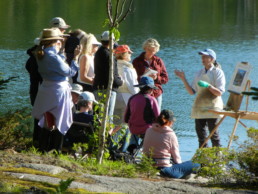
Connie Hayes leads a painting workshop on Vinalhaven.
During her time on Vinalhaven Hayes stayed at a friend’s house in Old Harbor. And that’s where she met Addison Ames.
Ames is a lobsterman and forester. He is a lean man, hard-forged, who moves fast and speaks fast, his full Maine accent occasionally obscuring his words. Unlike Hayes, he enters into conversation at full speed, telling stories, jokes and quips at a galloping pace.
Ames was using the wharf that was part of the property where Hayes stayed, landing his lobsters and storing gear there. One day he went up to the house and introduced himself. Soon, Ames was visiting with Hayes in the evenings after he had put his boat on the mooring. The lobsterman and the artist talked about those things that islanders think about: the weather, the ferry schedule, the vagaries of island living. And about art.
Ames has dark eyes. Like many lobstermen, he moves his body carefully and with great efficiency of effort. As he recalled, Hayes’ paintings affected him like an itch.
“I wanted to understand how it was done, how it worked,” he said. After all, Ames is known on Vinalhaven as the “tree curator.” With his brother Danny and other members of the family, he runs a company in the winter that does site clearing and forest maintenance—“landscape forestry,” as he terms it. To his business he brings the talent of vision.
“The woods talk to me,” Ames explained. Before he begins clearing, Ames will walk the land to know it and to ask questions. Where can one see the sun and when? Where is the water? Where are the rock formations or level ground? He is not there to scrape the land clean but to shape it to an image he carries in his mind.
The lobsterman and the artist talked about those things that islanders think about: the weather, the ferry schedule, the vagaries of island living. And about art.
“You discover things when you are out there,” he said, “plus there’s the history of who was there before. I’m often just copying what the old folk did before me.”
Hayes and Ames became friends. The artist and the lobsterman shared a sense of the numinous. Hayes pursues what she terms “perceptual painting.” Perceptual painting means watching and waiting for the crux of the thing, whether it is a house, a boat, or a bunch of boxes leaning against a wall, to reveal itself. It is the moment of astonishment that the artist tries to transfer to canvas.
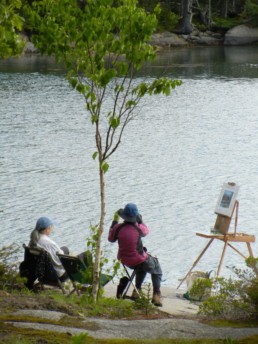
Ames invited Hayes to come with him to certain spots on the island where she might find a subject to paint. Occasionally, he would row Hayes to Greens Island, knowing there was something special there for her. The route took them past Burying Island. At times, the compact little island caught the afternoon sun; at other times fog drifted past in thin ribbons.
Hayes’ trips with Ames and throughout Vinalhaven produced paintings of seeming simplicity that are a far cry from the pretty scenes so often associated with the island. Vinalhaven’s beauty seeped through Hayes’ strong colors and shapes, not in dainty lines.
“Surface appearance and deeper understanding are two very different levels of knowing that can blend in the process of painting,” she explained. “That process can help to keep picturesque sweetness at bay,” a quality that may be hard to avoid in an island landscape.
“Seeing and looking are different things,” she said. “Looking comes from you. You look at a house. Seeing comes from the object back to you.” To see means to apprehend something ineffable about the object viewed. That is the core of an artist’s ability. The eye sees more than is evident. The commonplace is not common.
On a fine summer day, I sat waiting for the ferry to carry me from Vinalhaven across Penobscot Bay. I had tromped about for hours, visiting the historical society, the Carver Cemetery and Lane’s Island Preserve. I was tired and to rest my eyes, I took off my glasses.
I have worn glasses for nearsightedness since I was very young. They link me to the real world—without them, objects lose their definition and become something… other. That afternoon the sun’s rays bounced in fuzzy halos off the rocks around me. The ferry coming ‘round the point was a figment of white passing over a swath of blue. A nearby pile of color that I knew to be a collection of lobster trap buoys took on another meaning, one that again, I could not put words to. I didn’t want to. Astonishment is always there. You just have to see.
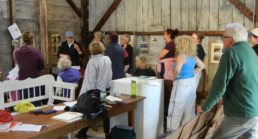
Melissa Waterman is an environmental writer whose work has appeared in numerous New England publications. She is intrigued by the complex ways people interact with the natural environment and by the overlap of science and human creativity.
Arctic Observations
Arctic Observations
By Peter Ralston
Last summer, photographer and Island Institute co-founder Peter Ralston boarded a friend’s yacht just above the Arctic Circle on the west coast of Greenland to explore that area, as well as the heart of the high Canadian Arctic archipelago. It was the trip of a lifetime among some of the world’s most remote islands, offering a front-row seat in the planet’s most dramatic theatre of rapid climate change.

After our first stop in Greenland at Qassiarsuk, where the temperature on July 25 was a near-record 72˚F, SY Rosehearty visited a couple of Greenland’s smaller ports before dropping the hook off Ilulissat, home of the northern hemisphere’s fastest moving glacier, the Jakobshavn. Our proximity to Big Ice here set the stage for our upcoming month of constant exposure to unexpected indicators of climate change.
Ilulissat is Greenland’s third largest city, population 4,600. Shrimp, cod, halibut, salmon and seal fishing are important here, but eco-tourism is now the biggest business. There’s a UNESCO World Heritage site here which caters to those who come to see the ice….while it’s still here. Although the beauty is nearly overwhelming, what might otherwise be a festive air is undermined by a low-key vibe of eco-tragedy.
Just in the past 15 years the Jakobshavn glacier’s face has retreated more than it did in the previous century; since the 1990s the Jakobshavn has nearly tripled its flow rate and now annually averages something like 6 feet an hour.
Just in the past four years, more than a trillion tons of ice have been lost here. This is 400 million Olympic swimming pools’ worth of water, or enough to fill a single pool the size of New York State to a depth of 23 feet. Even though this particular ice drainage basin is smaller than the one in Greenland’s northeast, there’s enough ice in it alone to raise global sea levels by two feet.
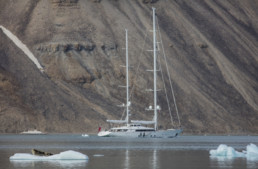
The only seal we saw on ice the entire trip
After a subsequent two and a half-day passage across Baffin Bay, we steamed into the Canadian Arctic at the Inuit hamlet of Pond Inlet on northern Baffin Island. Our entry into the polar desert, where annual precipitation ranges from 5 to 8 inches, immediately revealed an altogether different world than what we had seen of Greenland.
On the Canadian side, the severe and austere beauty dominated all else…but for the constant reminders of how much and how quickly elemental ways of life are changing. In the territory of Nunavut we saw much wildlife, visited four Inuit hamlets and hunting camps, and we covered over 1,000 miles in the heart of the Arctic archipelago. Last year was the planet’s hottest year on record, with resultant record-breaking ice loss, and while up north we saw virtually no sea ice. We could have easily completed the once impenetrable Northwest Passage had that been the goal.
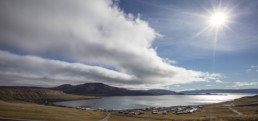
The Inuit hamlets were stark reminders of Maine island towns, but there was an air of impending doom about them. The residents are some of the nicest people I have ever met, yet the dire reality of climate change hung heavy about them. Theirs is fully a hunting culture, yet there is now fundamentally no hunting except in the winter when there is some ice. No ice equals no seals equals no food….for the Inuit, their dogs and for the bears. The loss of ice there is comparable to what the loss of fishing and lobstering would do to Maine’s fishing communities, except the devastation will be more complete in the Arctic as there are simply far fewer alternatives.
Critical lessons abound in the Arctic and now, having been there, I am compelled to sound the call for awareness, support of science and personal engagement. We ignore reality at our own peril….and that of all of our descendents.
The stunning beauty of Ilulissat’s Big Ice goes hand-in-hand with the reality that it is dying. My impression from the ground, the boat, and from the air was that, as New Englanders, we know the difference between healthy snow and ice fields, and the rotting, leaking, ugly vestiges we see come mud season…which was the inevitable comparison gleaned from what we saw.
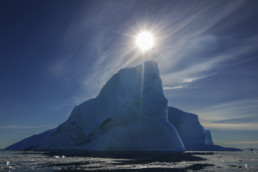
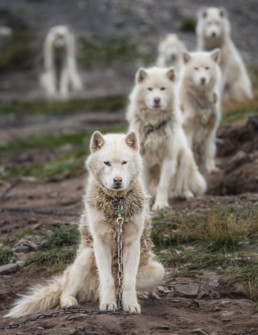
In 1995 there were some 8,000 sled dogs in Ilulissat, today there are approximately 2,000. This was the first sign we observed of the critical role ice plays in the daily life of the Inuit. Ilulissat’s mayor has said “The last time we had ice we could use was 1997,” and that diminishment of sea ice led to greatly decreased access to seals and fish. We learned that throughout the Arctic, hunters are being forced to shoot their dogs…a tragedy that cuts to the core of Inuit life. An early 18th century missionary to Greenland discovered that the native people had no word for bread so he translated the line from the Lord’s prayer as “Give us this day our daily seal.”
While in Arctic Bay, northern Baffin Island, I came upon this man tending his gillnets. In addition to the expected Arctic Char, he also caught four hefty Atlantic Salmon, a species never before seen in these parts. A month after returning back to Maine, I read an article that referred to Inuit “claims” that they were catching salmon there. It’s real, and it’s an extraordinary indicator of how fast these waters are warming and allowing new species to establish themselves.
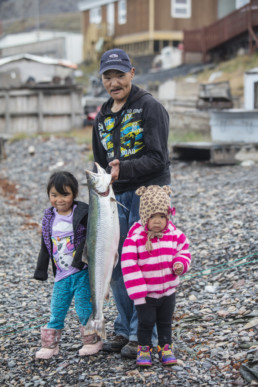
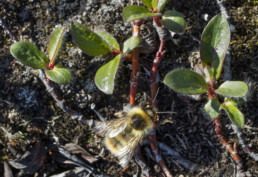
While tracking a musk ox on Devon Island, Nunavut, the world’s largest uninhabited island, at 74˚33’ N, I paused to photograph some of the exquisite and defiantly colorful little flowers that grow in this, the world’s harshest climate. To my complete amazement a slow-moving Arctic bumblebee, Bombus Polaris, lurched into my viewing screen. They are spreading their range further north as the Arctic warms.
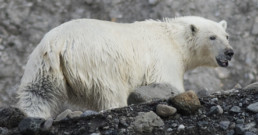
We saw thirteen Polar bears in Nunavut. These magnificent apex predators are impressive beyond words, yet with the loss of sea ice, they are unable to hunt seals and are thus increasingly starving. Compounding the threat to their existence is the Inuit need to survive by, among other resource-based enterprises, catering to wealthy hunters, as well as selling bear and other animal parts to the increasing number of tourists passing through the region.
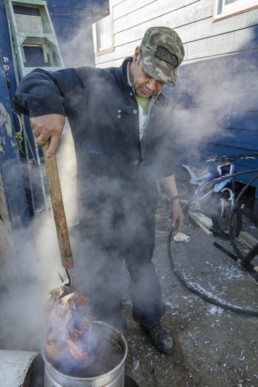

Every day in Nunavut was like steaming through the magnificence of the Grand Canyon, Yosemite and Monument Valley but I could never shake the awareness of impending loss and change.
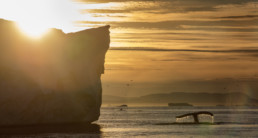
I implore you to view the extraordinary film, Chasing Ice, the most dramatic moments of which depict ice the size of Manhattan Island calving off the Jacobshavn. And please, read the October 24th New Yorker piece by Elizabeth Kolbert titled A Song of Ice – What Happens When a Country Starts to Melt. Both can be found online.
The day after the first public presentation of my Arctic images, someone sent me this excerpt of an extraordinary poem, Hieroglyphic Stairway, by Drew Dellinger… in my mind it is a call-to-awareness and action that really does say it all.
Climate change is not a Chinese hoax. Yet there is a “spiral of silence” around the subject insofar as most people rate it high among their personal concerns but do little or nothing. It simply isn’t sufficiently discussed, much less accorded the action it demands. There are important leaders who have publicly disavowed climate change which, in my mind, constitutes reckless endangerment on a scale the world has never before witnessed. What will you do?
– PMR
Making It Here: The Island Educator
Making It Here: The Island Educator
Monhegan’s one-room school teacher turned her back on New York City.
By Kathy Westra
The first time Monhegan Island’s teacher, Mandy Metrano, laid eyes on the island she now calls home, she was not impressed. In 1995, as an 18-year-old high school student on a visit to see her boyfriend, a summer resident, she saw Monhegan as “all ocean and dirt roads and nothing happening. The only evidence of nightlife was a bunch of kids playing Hacky Sack under the island’s only street light,” she remembers.
A year later, her boyfriend had lined up a summer job waiting tables at Monhegan House, but Metrano had planned to spend her own summer break traveling to India with a friend. When the trip fell through, her boyfriend, Jon, suggested she work with him on Monhegan instead.
This time, the island stole her heart the day she arrived.
“We took the early boat and even when we got close, we couldn’t see the island because it was so foggy. We could hear the foghorn, though, and as we approached the dock in the fog I heard bagpipes. It was magical.”
The end of that day was equally enchanting. Walking back to the ferry dock at sunset, she and Jon saw a young buck standing at ease among apple trees filled with hummingbird moths against a backdrop of “the most amazing painted sky with the sun setting behind Manana (Island).”
After that day, “Monhegan became part of me, gnawing at me, wanting me back,” Metrano confesses. She didn’t come back immediately, though. She spent some time in Portland, doing marketing work for a small natural products company. Then she landed a sales job with a natural products distributor in New York City. It was not a good place for a young woman whose heart was firmly planted on an island off the coast of Maine.
“I was depressed. I had no medical insurance. I had a sinus infection that lasted six weeks. One day I read my horoscope in the Village Voice and it said: ‘The material world is eating away at your sense of happiness.’ That was it. I thought: What am I doing here in New York? I need to go back to Monhegan.”
A week later, she was back on the island, working again in the dining room at Monhegan House. It took only a month to realize she was not going back to New York.
“All of my stress and anxiety had just melted away. When you’re surrounded by this vast ocean, your perspective changes.

Metrano lived on Monhegan year-round from 2003 to 2005, working in the café at the Trailing Yew in the summer, and serving as the sternman on a lobster boat in the winter, a job for which she had no training but which she learned quickly.
“That was the hardest physical work of my life,” she says. “I loved being out on the water, and got very strong.”
Her first time working in a classroom was in 2004-05, when she combined her job on the lobster boat with work assisting Sarah Caban, then the teacher at the island’s one school.
“Sarah needed an ed tech and hired me. She was a great role model. She was a really compassionate, organized, creative teacher with lots of energy who was able to meet each student at their personal level of learning.” Since becoming the island’s sole teacher three years ago, that’s something Metrano has incorporated into her own practice, and it’s noticed and appreciated by the islanders.
Winnie Murdock, who has lived on the island with her husband John for 40 years, has high praise for Metrano. Murdock’s children went to the island school and now her four grandchildren attend it.
“What’s really special about Mandy is how willing she is to meet each student where he or she is. That’s her greatest strength and what makes her such a perfect fit (for the small, multi-grade school),” she said. “The success of an island school is totally dependent on the teacher. If you have a good teacher like Mandy, you have a good school. We all feel really lucky to have her.”
Although she and her classroom assistant, Nancy Vogt, are the only educators on Monhegan, Metrano gets to interact with teachers from five other island schools through the Island Institute’s Outer Islands TLC (Teaching and Learning Collaborative). That group holds bimonthly meetings, and the teachers collaborate on science and social studies curricula and teach each other’s students in virtual book groups. “They are a lifeline,” says Metrano of the other teachers. “It’s a very supportive and helpful group.”
She finds the flexibility of teaching in the one-room, multi-age school liberating. “Sometimes I think it would be easier if someone just handed me a curriculum and said, ‘Here you go,’” she says. “But the truth is, the kids lead me to how we’re going to learn about something, and I’m amazed at the empathy and leadership that develop spontaneously when older students learn and play with younger students.”
Metrano, now 40, lives with her husband on the island all year, teaching full-time during the school year and working at the front desk of the Island Inn during the summer.
Although she loves living on the island, she concedes that island living has its challenges, one being that whenever she does get to the mainland, her limited time there is so crammed with things to do—errands and visiting family and friends—that she often feels she doesn’t have enough time to make deeper connections with the things and people that are important to her on the mainland.
Asked if she envisions this life as a long-term plan, Metrano says she and her husband “are taking it one year at a time.” Right now, she is exactly where she wants to be.
“I have not ever been bored as a teacher. Every day is different. I am always facing new challenges and learning new things. The real question will be if I have given the kids what I have to offer and it’s time for someone else to share their unique gifts and teaching style with the island kids. If I start to bring repetitive, uninspired ideas to the table then it will be time to change it up.”
Kathy Westra is a former development and communications director of the Island Institute who now owns a Rockland-based environmental communications business, Your Green Voice. She and her life and musical partner, George Stephens, divide their time between Rockland and Eastport, and perform folk music deeply rooted in nature and the special places like the Maine coast that they both love.
Making It Here: The Island Caretaker
Making It Here: The Island Caretaker
Islesboro’s Lars Nelson has decades-long connection to family and house.
STORY AND PHOTOS By TOM GROENING
The phrase, “It’s all about relationships,” is an over-worked cliché in describing a job. But for Islesboro’s Lars Nelson, it’s ideal.
Nelson, 66, has worked on the island as a caretaker for a handful of summer folks for 40 years. He’s a private, modest man, and the “relationship” idea emerges only through casual conversation, as he reveals the history he has had with families and with the island’s cottage-style mansions.
Stopping on a late winter day at one of the houses he cares for—owned by a family whose name would be familiar to most Americans, but which he does not want to disclose—Nelson remembers sailing with the family along the Nova Scotia coast. He was working as a crew member, but it was an experience he remembers as a gift, especially since he was able to bring his son along for the voyage.
This wealthy summer family has even purchased gifts for Nelson’s two children on their birthdays, a gesture that has touched him on a personal level.
As he walks from the driveway to the front of the house, which offers long views over eastern Penobscot Bay, the professional relationship emerges. Nelson looks over the shingled exterior of the home with the fussy eye of a librarian able to spot an out-of-place book. When the contractors who are replacing a glass door see him, they stop work to report their progress. This is part of caretaking, being present, being the owner’s eyes and ears as these century-old houses get the tender, loving care they seem to perpetually need.
With all sorts of digital monitoring devices and services now available that register motion, temperature drops and heightened humidity, it might seem the caretaker is obsolete. Not so.
Nothing can replace a caretaker’s relationship with a house, Nelson explains. He believes he has developed a sense about the place so that he almost knows when something’s gone wrong.
“It’s like how a plumber can hear a drip in the house when no one else can,” he said. Sometimes, he’ll swing by in his pickup truck on a windy, winter afternoon, and—sure enough—find that a door has blown open. And if a monitoring device does notify him about low heat, it is he who must drive over at 2 a.m. in January to try to fix the problem while waiting for a plumber or heating contractor.
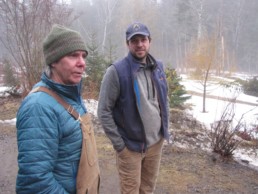
It’s rare that a day goes by without a visit to this house.
“We touch base, this house and I,” Nelson says. “We have a relationship.”
If he’s going to be off-island, he arranges for someone else to stop by and look things over. His son, Nakomis, and his wife, Maxine, who does gardening for summer residents, often help.
Summers are especially busy.
“In the summer, it would be 7 a.m. to 8 p.m.,” Nelson says of the length of his days.
Caretakers working for summer island residents tackle a wide range of duties: plowing the driveway in winter, clearing fallen branches after storms, registering and maintaining the island cars, supervising subcontractors, ordering construction and landscaping materials, doing minor repairs, stocking the house with food and other supplies if the family plans a spur-of-the-moment visit, and arranging for visitors to arrive via airplane or ferry.
“When they need you, you show up,” he says. “You’ve got to be able to listen, to hear what people want.” The summer folk are savvy about the service they expect, so being accountable, reliable and honest are key.
“I enjoy it. The places I work, I’ve been there so long. I do a little bit of everything, except carpentry and plumbing.”
Though wary of disclosing too much, Nelson acknowledges that he is paid a salary, much like a retainer, for his work. These days, more summer folk are paying caretakers by the hour, he notes.
And island caretakers help each other.
“You rely so heavily on your relationships,” he says. “That camaraderie is genuine.”
Like many who have chosen island life, the story of Nelson’s landing on Islesboro is wrapped up with his values and identity.
He was born in Sweden, but was adopted at birth by a family of Swedish descent in Salt Lake City, Utah. His grandparents had a house on the north end of the Islesboro, and he was drawn to it.
After some study at Maine Maritime Academy, Thomas College and the University of Southern Maine, he came to Islesboro and built a log cabin on the family’s land with Ben Moody, an older Islesboro native.
In 1971, Moody offered him work if he had a chainsaw and a boat.
“I didn’t have either,” he recalls, but was able to borrow them from his parents, and worked cutting trails on privately owned Job Island. That led to other island summer jobs.
Moody, long dead, remains a mentor figure to Nelson, as he explains that much of what the older man imparted didn’t take hold until years later.
“There are so many things he whispered into my ear,” Nelson said, which he finds guide him in his work today. It was Moody who in the mid-1970s turned over the caretaker job of the house we visit to Nelson.
“For me, this island is just enchanting. It’s a heaven for me. I feel so privileged. I love doing what I do. It’s just so satisfying to do something with your hands.”
Tom Groening is editor of Island Journal.
Making It Here: The Island Electrician
Making It Here: The Island Electrician
Goodell Electric keeps the lights on for North Haven.
By Courtney Naliboff
Photos by WILLIAM TREVASKIS
With a truckload of parts and a helper by his side, Trenor Goodell has kept Goodell Electric alive on North Haven for over a decade. Island life, while posing unique challenges, offers an interdependency that Goodell attributes to his success at making it here.
“That’s one thing about islands—we support each other, and almost every business owner would rather spend their money locally and support their fellow islanders, so that’s worked out well for all,” he says.
Goodell moved to North Haven from Peaks Island in 2005 with his family. Though he studied electrical engineering at the University of Maine in Orono, he was drawn to the electrician’s trade.
He and his wife saw electrical work “as a way to live where we wanted to, to give me the flexibility to be an employer as opposed to an employee, and run my business in a location that I enjoyed,” Goodell says.
Goodell employs a full-time licensed helper and says he’s proud to be able to offer a living wage. Although no one has taken him up on the offer, he says he would help defray the cost of coursework for a helper to work towards a master electrician’s license. He sees the trades as a pathway to a living wage without the burden of college debt, and encourages high school students to consider a two-year trade program as the fastest way into the field.
North Haven provides Goodell Electric with a variety of jobs, from new construction to critical repairs at the school.
“You have to make the town run, whatever it takes. We do repairs at the ferry service, anything that’s necessary,” he says. At 7:30 each morning, Goodell and his employee leave from his home shop, alternating between service days and days spent “roughing in” at a construction site. For a customer without heat or hot water, Goodell makes the effort to arrive quickly.
“Our service call response for an emergency is on the order of an hour or two, and on an island people really appreciate that,” he says.
Goodell Electric’s quick response time and professionalism keep island contractors calling.
“He’s actually super responsive,” says Abel LaBelle, owner of LaBelle Building. “I call him and he might come over the same day or the next day if it’s a small thing that needs to be taken care of. It’s hard to believe you’d get that most places.”
Goodell Electric also works closely with Cooper Construction.
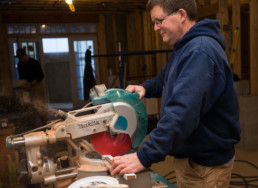
“Service calls are a service that we do for people, but it’s the building projects that make the business viable and sustainable,” he says. “Without those we’d have to go elsewhere.”
Goodell Electric also works with many non-construction-related island businesses and facilities. He’s been involved in major projects, such as renovations at the town office and work at Nebo Lodge, Turner Farm, North Haven Brewery and PM Auto.
“We’ve had a good reciprocal relationship with the local businesses,” Goodell says.
Owning a business on an island has some obvious challenges.
“I carry more inventory than my mentor on the mainland because he could just run to a store, but I can’t just run to a store.”
— Trenor Goodell
“We have a $50,000 inventory of components and things because we’re on an island. I carry more inventory than my mentor on the mainland because he could just run to a store, but I can’t just run to a store. I’m out of work for a day if I don’t have what I need,” Goodell says.
In a real pinch, Penobscot Island Air has become a new resource.
“I’ve been using PIA lately—the plane’s been able to help us out. I had a customer who lost the main breaker on his house. We flew it in the next day.”
Despite the challenges, Goodell finds island business ownership worthwhile.
“There is satisfaction from building things, making things, maybe leaving something behind–your life’s work that you can see, you can touch,” he says.
Courtney Naliboff teaches music, theater, and English at North Haven Community School. She writes about rural Jewish life and parenting for Kveller, ReformJudaism.org, The Working Waterfront, and the Frozen Chosen blog for the Bangor Daily News.
Making It Here: The Island Telecommuter
Making It Here: The Island Telecommuter
Christopher Loder works for IBM from Chebeague.
BY JENNIFER VAN ALLEN
PHOTOS BY GABE SOUZA
After decades of painstaking planning, Christopher and Caroline Loder moved to Chebeague Island in 2013, intending to work remotely and give their three children a life that wasn’t possible on the mainland.
But they got a surprise on move-in day, when Loder picked up his cell phone to make a call.
No bars. No service.
They refused to be disheartened.
“If you move to an island, you didn’t choose the easy path,” said Christopher Loder, 47, who works as an “offering,” or new, digital-product management for New York-based IBM Digital Group. “If you’re in the middle of the ocean (on a boat) and the head is clogged, you fix it yourself. It’s the same thing on an island. We’ve been to remote places in the world, and solved bigger problems than this.”
And they did.
He and his wife, an artist, designer and art director, installed a landline so they could make calls without worrying about dropped signals. To get cell service, they invested $1,500 to install a 27-foot tower with an amplifier. Chebeague.net (now Axiom Technologies) provides the commercial-grade DSL service they need for internet access.
Among the islands, Chebeague was on the forefront of digital connectivity. The 10-year-old network was Maine’s first community-based broadband network.
“Part of the unwritten code of working remotely is that you don’t let connectivity issues get in the way of work,” said Loder. He spends four to five hours each day on conference calls, and about half of his work is done by videoconference. “Dropping a signal or a call in the middle of a sentence, let alone a dialogue, is unacceptable.”
If the power goes out or a connection goes down, Loder works from his truck at the end of the driveway that faces Portland, and tethers to a mainland link on his cell carrier. Not exactly “convenient,” he conceded, “but it does make for some interesting video calls.”
Monthly commuting costs, both family and work-related, amount to less than $100—far less than what the Loders would spend on gas or public transportation commuting in a big city. Most importantly, they don’t spend hours of their lives sitting in traffic.
“I can’t imagine doing that to your soul,” said Loder. After years of living all over the globe, the Loders cherish the sense of interdependence they feel on Chebeague. It’s a sharp contrast to the anonymity and isolation they often felt while living abroad in big cities like Munich, Germany, where they didn’t speak the language.
Loder loves that he interacts with so many of his neighbors in so many different ways. After all, with just 425 year-round residents, everyone on Chebeague must wear multiple hats.
For instance, as a rookie volunteer for the island town’s fire department, Loder reports to the fire chief, Ralph Munroe. During the previous year that Loder chaired the board of selectmen, Munroe reported to the board. Munroe also works in the boatyard caring for the Loder’s 30-foot sailboat.
“We have four different types of relationships, the most important of which is friendship,” said Loder, who also serves on the town committee for tax-acquired property.
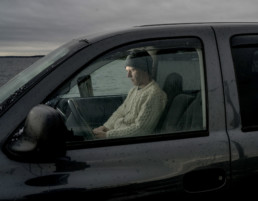
Loder sometimes must make telephone
calls from the cab of his pickup truck
to ensure a strong signal.
“Living in a small community, we’re able to move between those relationships fluidly, with respect, camaraderie, a sense of humor, and commitment to community as well as your own needs,” he said. “To me, that’s what’s missing in the world.”
The Loders also relish the education that their kids, who are ages 6, 8, and 10, are getting at the Chebeague Island School.
With 26 students of a wide-range of ages, “you get a very diverse set of learning and a sense of multi-age camaraderie,” Loder said. “We believe that education is a combination of experience and textbook learning. The social learning is frequently more important.”
Traveling for face-to-face meetings, which Loder does up to 12 times a year, is surprisingly less of a challenge than it was when they were living in Portsmouth, New Hampshire. If he times it right, Loder can go from his kitchen to the Portland Jetport, within an hour. As a backup, he uses the water taxi, or gets a hotel room on the mainland.
The hurdles of telecommuting from Chebeague are the same ones Loder has had to manage no matter where he’s lived in the 17 years that he’s been telecommuting.

“Dropping a signal or a call in the middle of a sentence, let alone a dialogue, is unacceptable.”
— Chris Loder
Though he doesn’t have to fend off traditional office space nuisances, like chatty co-workers hanging around his cubicle, he does have to be extremely intentional about distractions, and reserve breaks for necessary to-dos like feeding the chickens and accommodating fuel deliveries.
“Life always interferes with work,” he said. “But when you’re telecommuting, you’re the person who has to drive the discipline.”
If there’s any challenge to living on Chebeague, it’s that any spontaneity requires careful planning. “Anytime you leave, you’re on a stopwatch,” he said. If he has an hour and 45 minutes to do two-and-a-half hours of work, “life becomes an optimization algorithm with dynamic triage and real time re-prioritization.”
That means sometimes you skip a to-do or wait for the next ferry.
“And it means that movie dates often end before the credits role.”
Jennifer Van Allen is a freelance writer whose work has appeared in The Washington Post, Runner’s World, Prevention, Running Times, The New York Times, The Portland Press- Herald, MaineBiz and other publications. She also has co-authored four books about health and fitness, including Run to Lose: The Complete Guide to Weight Loss for Runners (Rodale, 2015). She lives in Falmouth with her husband and son.
Making It Here: The Island Lobster Marketer
Making It Here: The Island Lobster Marketer
Vinalhaven’s Emily Lane works the phone to build demand for Maine’s signature seafood.
By TOM GROENING
Photos by WILLIAM TREVASKIS
Without the work that connects lobster with customers around the country and world, Maine’s iconic seafood would be a local, seasonal snack. And without that effort, the iconic lobsterman—who in 2016 shared in $533 million in sales—would be a quaint and anachronistic figure, perhaps reduced to part-time work.
Thanks to people like Emily Lane, though, lobster is in steady and ever-growing demand, from California to Korea, from cruise ships to haute cuisine restaurants, in ready-to-microwave ravioli to still-squirming in the crate at a beachfront cookout.
As is the case with many islanders, Lane, 69, willingly accepted the career limitations that living on Vinalhaven presented. Yet she figured out how to thrive–and to do so by supporting a community and industry she loves.
Catch her at work today and you might overhear her talking to a buyer in Italy or Spain, illustrating that a technology as old as long-distance phone service still opens doors and provides islanders with opportunity. But her career as a lobster marketer wasn’t predestined.
Lane grew up in Wellesley, Massachusetts, and earned a degree at the University of New Hampshire in English literature, with minors in history and speech therapy. While she got her start out of state, she did have ties to Maine and to the seafood industry: her mother was born in Woolwich and grew up in Augusta, and her grandfather was the state Department of Agriculture’s chief inspector, ensuring that seafood and produce were safe to consume.
After graduating college in 1970, she began a career in education, teaching first at Mount View High School in western Waldo County and then, just a year later, settling in Vinalhaven to teach remedial subjects at the town’s school.
“I really fell in love with the community,” she remembers, “and over the years, I became very deeply involved.” She fell in love, too, with Tim Lane, whose ties to the island go back generations–his great-great-grandfather had been a sea captain.
She took time off to raise their two sons, but it wasn’t long before locals recognized in Lane what is readily apparent today: she’s smart, focused on doing the work, and unconcerned with getting credit. In short, a leader who could effectively advocate for the fishing community.
“I fell into the fish business. English lit majors had to be creative in what they did,” she jokes. “I probably wouldn’t be doing what I’m doing now, if I lived on the mainland.”
“Fishing constitutes so much of the economy. That’s why I have such a passion for this work.”
— Emily Lane
She was recruited to serve on the board of directors of the island’s now-defunct Pen Bay Fish and Cold Storage business operated out of the town-owned fish plant. By the late 1980s, she had been pressed into service running the company.
In the early 1990s, Claw Island Foods came to the island to lease the fish plant and process lobster. Lane eventually became general manager, overseeing domestic and international sales. The business closed in 2010.
In 2006, board members with the Vinalhaven Fisherman’s Co-op approached Lane about helping manage the operation.
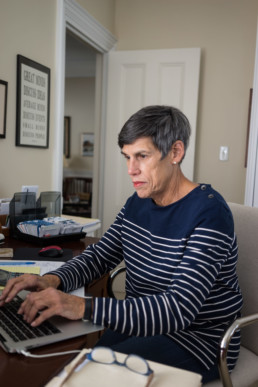
“They were experiencing some serious and challenging financial downturns,” she remembers. With the late Ted Johansen, she collaborated on restructuring loans and securing new financing to get the co-op back on its feet. In 2013, Lane returned after a three-year hiatus on the mainland following the death of her husband.
Since then, Lane has run the organization on a part-time basis, though she can’t speak the “part-time” phrase without a rueful laugh, suggesting she spends a lot more than 20 hours a week on the job.
“Fishing constitutes so much of the economy. That’s why I have such a passion for this work,” she says.
In 2010, she joined Calendar Islands Maine Lobster Company as vice-president of sales. She describes Calendar Islands as a “supply chain partnership between Maine lobstering families, talented chefs, and the best dockside lobster processing operations.” The company offers a number of traditional and value-added lobster applications.
Lane specializes in export sales and has working relationships with buyers in more than 15 countries in Asia and Europe. Her role today as a lobster marketer is not so far removed from her first role as a teacher: education is a big part of her work.
“I try to educate my customers,” she says. “I bring some of my customers to the island for them get a feel for the industry,” a move that invariably leaves buyers impressed with Maine lobsters and the communities they sustain.
“It’s all about developing relationships, and transparency with your customers,” Lane says, explaining how she can be effective in her role as lobster marketer. “I give my buyers the best possible information on the industry.”
She thinks it’s important to educate not just those buying lobsters–her customers–but the fishermen, too. Fishermen, Lane believes, are often too removed from the markets in which their catch lands. She tries to educate them about the links in the chain, and the associated risks. The Vinalhaven Fishermen’s Co-op encouraged some of its members to attend the Boston Seafood Show so they could witness first-hand how marketing dollars are being spent.
Marketing efforts take significant investment. Calendar Islands Maine Lobster devotes a five-figure budget to have a presence at the global seafood expo held in Brussels.
“It’s a very significant show for our company,” she said. Every edge makes a difference in an export landscape impacted by free trade agreements, ever-changing regulations, and fluctuating economics.
Her efforts and the efforts of others who advocate for Maine’s lobster industry are paying off.
“Companies are now using lobster to develop new recipes and are offering innovative, easy-to-prepare, value-added products to both food service and retail sectors,” she explains. And fishermen are now included as spokesmen and stakeholders in those companies.
Lane’s lobster advocacy goes far beyond her job, though. Her passion for the fishing industry and her island community led her into civic involvement.
This spring she will finish the final of four terms serving on Vinalhaven’s board of selectmen. She’s also done stints on the school board and planning board.
Lane also has served on lobster promotion groups, and is currently a member of the Maine Lobster Marketing Collaborative Advisory Board. She has served on the state ferry advisory board, and on a statewide board that oversaw community action agencies.
In 1984, she ran for a seat in the Maine House of Representatives, winning by 10 votes—a margin that reversed to a 10-vote loss in a recount.
And Lane is vice-chairwoman of the board of trustees for the Island Institute, publisher of Island Journal.
She readily admits to having taken unpopular positions at times—something an effective leader typically has on her resumé.
“I have strong opinions and a strong work ethic,” an assertion no one who has seen Lane in action would dispute.
Making It Here: The Island Hotelier
Making It Here: The Island Hotelier
Phil Crossman’s Tidewater Motel represents the important tourism sector.
By PHIL CROSSMAN
Photos by WILLIAM TREVASKIS
One day this past summer one of my guests, visiting with his wife and enjoying a waterfront berth here at the Tidewater Motel on Vinalhaven, answered my customary query by responding that this had been the best day of his life and thanked me profusely for providing it.
Imagine! He’d lived 60 or so years in some other place or maybe places all over the world, and I’d provided him with the best day of his life! They were first-time visitors to the island and, for a moment, I wondered at how dull those 60 years spent elsewhere must have been for this day of modest activity to have provided him with such a delightfully quantifiable experience.
But upon reflection, I realized that my initial assessment was the product of having grown complacent about my own good fortune. He had been kayaking that morning among the seals in the Basin, a pristine and largely protected 350-acre inland salt sea on the island’s southwestern side. After enjoying the world’s most perfect lobster roll at Greet’s Eats, he and his wife had boarded the SeaBreeze, a 42-foot lobster boat piloted by the affable lobsterman Bobby Warren—who is always eager to meet and learn about new people and share his own experiences—for a cruise of several hours around Vinalhaven and among its many outlying islands. Grateful for having been reminded of my own blessings, I sent him off to what would prove to be a memorable dinner at The Haven and a perfect end to the best day of his life.
Prior to creation of the Maine State Ferry Service in the 1960s, Vinalhaven was served by an assortment of wooden vessels, the last of which carried a couple of cars and 20 or so passengers. There were then several little lodging facilities on the island: The Bridgewater, Downeaster, and Islander inns and one or two others, and these were largely home to repeat guests who came year after year and stayed several days or a week. These were stalwart folks, accustomed to the unpredictable boat rides that often found less-seasoned travelers tucked into the crowded little passenger cabin, passing a “slop jar” around as needed.
My folks occupied a big house and, with two or three of their four boys off on their own or nearly so, my mother decided to augment my carpenter dad’s modest income by “taking in boarders.” One of her first guests was Garry Moore, host of “What’s My Line,” a popular TV series of the time.
With these few exceptions, tourism was otherwise limited to the population of seasonal residents who had summer homes either in the village or tucked away farther up the island in great rambling “cottages” on the Fox Island Thoroughfare. These rusticators started arriving just after Memorial Day and settled in for the summer. They lived in another world and they remained somewhat in that other place, even while here for the summer.
Many of us, ignorant of and, I dare say, a little intimidated by that enlightened and cosmopolitan population and the world they knew, masked that insecurity in contempt. They were “summer jerks,” a term that allowed us the luxury of reversing the equation. In fact, of course, that annual influx was a “value-added” component of the town’s economy, without which it simply wouldn’t have survived as it did.
After the Maine State Ferry Service was born, allowing on each of several trips a day 10 or 12 cars and dozens more passengers, tourism took on a new life. Today, those boats carry upwards of two dozen cars, hundreds of passengers, and make six round trips a day.
“Many of us, a little intimidated by that enlightened and cosmopolitan population, masked that insecurity in contempt.”
— Phil Crossman
Interestingly, this development that spelled a big jump in the numbers of summer visitors also marked the beginning of the end of what had been a bustling retail environment. The larger and more comfortable ferry made for a more appealing ride to the islands for visitors. At the same time, it made for quick, easy, novel, and exciting shopping trips to the mainland for islanders who had, until then, contentedly done most, if not all, their shopping right here on Main Street.
Vinalhaven has been a fishing community for the better part of the last hundred years and the fished product has been pretty exclusively lobsters for the last 50 of those. The town’s gross income today is about equally split between lobstering and tourism or the businesses indirectly associated with or dependent upon them.
Still, among a minority of our own, there remains a certain disdain for seasonal visitors, for those of us engaged in providing services for those people and, for that matter, nearly anyone not engaged in lobstering. They are a macho-minority but not an invisible one.
Most of us, lobstermen and otherwise, enjoy and anticipate the annual migration and look forward to the return of old and new friends among the summer population. The few who don’t welcome those returning make their disapproval known in ways that are sometimes subtle, sometimes not. To these few, we who do not spend our days afloat are less deserving.
On the other hand, their numbers are diminishing and their disdain becoming less visible. Most of us have long since recognized the value and legitimacy of tourism and the enormous contributions some among our seasonal population have made to our quality of life across a broad spectrum. Once in a great while, someone “from away” shows up who is deserving of our scorn, and when that happens we make the most of the opportunity given us. On the other hand, the offenders have sometimes expressed their admiration for an inventive and well-executed retribution.
Today’s tourists are universally interested, foremost, in knowing where they can be fed and, between our island and North Haven, to which we can usually arrange evening transportation, we have a few choices. Nearly as many, though, are looking for things to do and most are more than content with the kayaking, birding, hiking, and boat rides or the occasional concert or speaker event. It’s those simple things, the natural beauty of the island and the vicarious appeal of sitting on a waterfront deck and watching the lobster fishing fleet go about its business that most find fulfilling. Those who don’t, who are looking for a little more excitement or for serious shopping or who find island accommodations “quaint” or “dated” are quick to move on and the numbers they leave behind are more than sufficient.
The season is pretty much from Memorial Day to Labor Day and while a certain population, far fewer in numbers, retired or with no kids in school, visit in September, there are no steps being taken to extend the season nor are there very many options. The island forest is largely coniferous so fall color is not what can be found in deciduous environments elsewhere in Maine. Besides, while we do generally enjoy the mass arrival after Memorial Day, we also like having the place handed back to us in the fall.
Phil Crossman has owned and operated the Tidewater Motel on Vinalhaven for about 25 years, and his parents ran it for about 15 years before he took over.
Making It Here: The Island Artist
Making It Here: The Island Artist
Islesford potter Kaitlyn Duggan embraces both business and creativity.
By TINA COHEN
Kaitlyn Duggan sees her life on Little Cranberry Island, also known as Islesford, as a seamless proposition. In exchange for the challenges of living and running a business on an island, she receives from that place an energetic zest that plows through all aspects of her life—potter, spouse, mom, and island citizen.
Duggan, 37, has had a connection with Little Cranberry since studying at the Maine College of Art in Portland. A teacher there, Marian Baker, worked at Islesford Pottery every summer, and one summer invited Duggan to join her. Duggan liked it, and a few years later, she and her husband Cory decided to move to the island full-time.
Through Cranberry Isles Realty Trust, an affordable housing group, they were able to acquire a house, which had been uninhabited for 40 years and was in need of a lot of repair. They have lived there year-round since 2008. Cory is a carpenter and works a variety of island-based jobs. Four years ago they added Bode, their son, to the family.
Duggan creates pottery in the majolica style. Like its European antecedents, her pottery is earthernware clay decorated with lively colors and designs from nature.
“I love getting out in the woods, in the garden, to the beach, and on the water,” she says. “The rich colors and patterned designs I use on my pottery are inspired by the plants, vegetables, and flowers that draw my attention in these places.”
Winter is her opportunity to spend time working in her studio, uninterrupted by interactions with customers. Bode sometimes works on art projects alongside her; other times, he is part of a childcare-swapping arrangement with a few other island families.
Getting supplies, like heavy blocks of clay, is perhaps her most grueling challenge. She has to drive to Portland to pick materials up, then drive back to the mail boat, “schlepping things from car on the mainland to boat to car on the island to studio.” There are no ferries that carry vehicles to and from Little Cranberry.
“I do every aspect of the business myself, which makes everything go very slowly,” Duggan explains. A shaky internet connection makes for communication challenges. “Doing updates to my web pages and social media becomes a practice in patience.”
She offers 60 different products in a wide price range, from buttons to candlesticks, dishware to earrings, but enjoys creating something new and different every year.
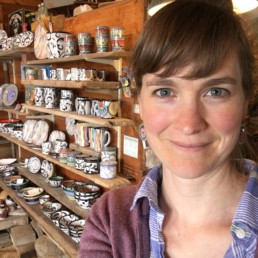
Duggan continues to sell her work at Islesford Pottery, which generates about 85 percent of her annual sales, but she also sells it year-round through Etsy, Instagram, and Facebook, and at Archipelago, the Island Institute’s store in Rockland. She also gets off-island to some craft shows in venues like Portland during the holiday shopping season. Selling her work on the island, though, satisfies her the most. There is a sense, she says, of the world coming to her. “The chemistry of those interactions (with summer visitors)—it’s a thrill.”
While working with her hands, employing her creative vision, and creating one-of-a kind pieces in pottery are all immensely satisfying, Duggan hopes that “the colors and designs I work with invite into the user’s life the same joy and pleasure I experience as I make the work I love.”
There is a strange paradox about living here. Despite limitations, I get the sense anything is possible.”
— Kaitlyn Duggan
She feels handmade pottery “counteracts the mass-produced products of a fast-paced industrial society.” She
appreciates a slower pace and “the ability to walk the same shore, the same roads again and again, each time noticing something new, while looking at the same familiar scenery.”
The island community also provides that opportunity, to notice the richness of possibility. “There is a strange paradox about living here,” Kaitlyn concludes. “Despite limitations, I get the sense anything is possible.”
Islands have held a fascination for Tina Cohen since she began visiting Vinalhaven in the early 1980s. She enjoys writing about people who live on islands. Besides writing profiles, arts reviews, and travel articles, Cohen works as a psychotherapist, and previously held jobs as an educator, archivist, librarian, and social worker.

